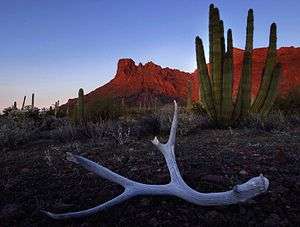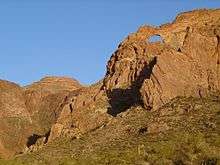Organ Pipe Cactus National Monument
Organ Pipe Cactus National Monument is in the Western region of Arizona in the United States.

Understand
More untouched and lush (for a desert that is) than more easily accessed American SW desert parks, Organ Pipe Cactus National Monument was created to protect its namesake, the organ pipe cactus, the monument being the largest concentration of the plant in the United States. It is in the extreme southern portion of Arizona. The visitor's center is less than 10 miles (16 km) from the Mexican border. The nearest large population centers are Tucson and Yuma, both over 150 mi from the monument, though several small towns with gas stations, hotels, and groceries are near the NORTHERN borders of the park, and other towns near the southern edge, if you want to drive across the Mexican border (the single US highway into the park continues directly into Mexico).
- 🌍 Kris Eggle Visitor Center, 10 Organ Pipe Dr, ☎ +1 520-387-6849. Daily 8:30AM-4:30PM.
History
Landscape
Flora and fauna
Though named for the Organ Pipe Cactus - the park has far more Saguaro cactus than those of the Organ Pipe variety - in far higher concentrations than say - Saguaro Cactus National Park, also of Arizona. In essence, the park is a relatively lush and untouched American SW desert environment, with a far higher concentration of cacti and other desert plants than perhaps anywhere else in the American SW - with a decent and best in US, but not exactly overwhelming (this is the northern end of its range), number of Organ Pipe Cacti interspersed.
Climate
| Organ Pipe Cactus National Monument | ||||||||||||||||||||||||||||||||||||||||||||||||||||||||||||
|---|---|---|---|---|---|---|---|---|---|---|---|---|---|---|---|---|---|---|---|---|---|---|---|---|---|---|---|---|---|---|---|---|---|---|---|---|---|---|---|---|---|---|---|---|---|---|---|---|---|---|---|---|---|---|---|---|---|---|---|---|
| Climate chart (explanation) | ||||||||||||||||||||||||||||||||||||||||||||||||||||||||||||
| ||||||||||||||||||||||||||||||||||||||||||||||||||||||||||||
| ||||||||||||||||||||||||||||||||||||||||||||||||||||||||||||
Get in
The only viable method to reach the park is via car. Arizona Highway 85 leads south into the monument. There is no public transit into the monument.
Fees and permits
The entrance fee is $8 per vehicle, or $4 for individuals. Entrance fees are valid for seven days. There is also an annual pass that allows access to the park for one year for $20.
There are several passes for groups traveling together in a private vehicle or individuals on foot or on bike. These passes provide free entry at national parks and national wildlife refuges, and also cover standard amenity fees at national forests and grasslands, and at lands managed by the Bureau of Land Management and Bureau of Reclamation. These passes are valid at all national parks including Organ Pipe Cactus National Monument:
- The $80 Annual Pass (valid for twelve months from date of issue) can be purchased by anyone. Military personnel can obtain a free annual pass in person at a federal recreation site by showing a Common Access Card (CAC) or Military ID.
- U.S. citizens or permanent residents age 62 or over can obtain a Senior Pass (valid for the life of the holder) in person at a federal recreation site for $80, or through the mail for $90; applicants must provide documentation of citizenship and age. This pass also provides a fifty percent discount on some park amenities. Seniors can also obtain a $20 annual pass.
- U.S. citizens or permanent residents with permanent disabilities can obtain an Access Pass (valid for the life of the holder) in person at a federal recreation site at no charge, or through the mail for $10; applicants must provide documentation of citizenship and permanent disability. This pass also provides a fifty percent discount on some park amenities.
- Individuals who have volunteered 250 or more hours with federal agencies that participate in the Interagency Pass Program can receive a free Volunteer Pass.
- 4th graders can receive an Annual 4th Grade Pass that allows free entry for the duration of the 4th grade school year (September-August) to the bearer and any accompanying passengers in a private non-commercial vehicle. Registration at the Every Kid in a Park website is required.
In 2018 the National Park Service will offer four days on which entry is free for all national parks: January 15 (Martin Luther King Jr. Day), April 21 (1st Day of NPS Week), September 22 (National Public Lands Day), and November 11 (Veterans Day weekend).
Get around
There is no public transit in the monument. Private vehicles or hiking are the only options for getting around.
See
- Evening programs, Twin Peaks Campground (amphitheater). Several evenings a week, talks are given at the campground on a wide variety ot topics. Check with the Kris Eggle Visitor Center or the Twin Peaks Campground for dates and topics. Free.
- Patio talks, Kriss Eggle Visitor Center (on the back patio). Daily: 11AM, 1PM, and 3PM. 20-30 minute talks on a variety of topics related to the history, geology, plants, and animals of the monument. Check with the Visitor Center for topics. Free.
Do


- Ajo Mountain Drive. A 21-mile drive through one of the most scenic areas of the park, into the hills and back down again. The road is mostly gravel or dirt, but is passable and often frequented by passenger cars. RVs 24 ft or longer are not recommended.
- Ajo Mountain Van Tour (meet at the Twin Peaks Campground information kiosk). Dec-Apr daily at 1PM. Rangers provide a guided tour on the Ajo Mountain Drive, stopping at several areas along the way to get out and explore. The tour is limited to 10 people per day, so sign up in advance with rangers at the Kris Eggle Visitor Center or Twin Peaks Campground. 3-3.5 hours Free (reservations required).
- Biking. Bikes are allowed on all roads open to vehicular traffic but are not allowed on hiking trails or in the backcountry.
- Geocaching. Geocaching is a sort of scavenger hunt using a GPS receiver to locate the hidden item. Organ Pipe is one of the few units in the National Park system to allow this hobby. Two geocaches are listed as being in the monument.
- Guided Hikes. Ranger led walks around the monument. Check the Kris Eggle Visitor Center or the Twin Peaks Campground for dates and times. Free.
- Hiking. Trails range from short, handicapped accessible trails to long, wild trails into the hinterlands of the park. Remember that portions of the park are restricted so be sure to check with the Visitor Center for trail closures and before starting an off-trail hike. Below are a few of the trails available:
- Alamo Canyon Trail
- Arch Canyon Trail (Ajo Mountain area)
- Bull Pasture Trail (Ajo Mountain area)
- Campground perimeter trail (pet friendly)
- Desert View Trail
- Estes Canyon Trail (Ajo Mountain area)
- Palo Verde Trail (pet friendly)
- Victoria Mine Trail, please stay on the trail
- Visitor Center Nature Trail
- Puerto Blanco Drive. Another car tour featuring roadside displays on the ecology of the Sonoran Desert.
- Visitor Center Nature Walk. A short walk with explanatory signs, and some notable (for size mostly) cacti, accessed from doors leading from the Visitor's Center. For basic photos ops, it probably beats most of the more rugged corners of the park.
Buy
Eat
Drink
Sleep
Lodging
There is no lodging in the monument. Ajo and other smaller towns are with 30 minutes of the park.
Camping
- 🌍 Alamo Campground. 4 tent sites, no water. Reservation only, made in the Kris Eggle Visitor Center on the first day of the visit.
- 🌍 Twin Peaks campground. Tents and RVs up to 40 ft, no hookups. Running water from standpipes and in restrooms. $12.
Backcountry
Due to border security concerns, the backcountry is closed indefinitely.
Stay safe
The monument is a remote, desert wilderness. Be sure to carry plenty of water both in your car and while hiking and drink regularly, even if not thirsty. If your car breaks down, stay with your car rather than attempting to find help on foot. It is much easier to find a vehicle in the desert than a person.
As mentioned above, the monument is on the U.S.-Mexico border. Due to the remoteness of the monument, it is used for illegal border crossings. Most of the persons illegally crossing present no threat to park visitors. However, there are some who use the monument for smuggling who are armed and dangerous. In 2002, a park ranger was shot and killed by a drug smuggler. The Kris Eggle Visitor Center has been named in his honor.
Visitors should be aware of their surroundings and report suspicious activities to park rangers or border patrol officers.
Go next
| Routes through Organ Pipe Cactus National Monument |
| Buckeye ← Jct W |
N |
→ |